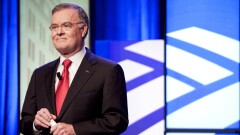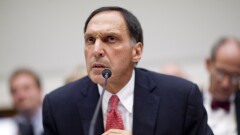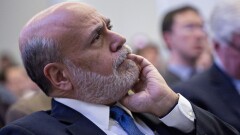Jamie Dimon and Lloyd Blankfein are still in their old jobs and Dick Kovacevich is a fixture on CNBC. But other crisis-era CEOs have kept low profiles, and many of them have failed to come to grips with the roles they played in the near-collapse of the economy. Scroll through to see where they and their regulators have ended up in the decade since the financial crisis.
John Thain and Stan O'Neal

O’Neal’s was an all-American story. A rare example of an African-American making it big on Wall Street, he advanced from General Motors assembly line to CEO of “Mother Merrill.” O'Neal, who joined Merrill from GM in 1986, was appointed CEO in 2001. The firm reaped huge profits in his first five years but ran into trouble by investing heavily in subprime mortgage bonds, then deepening its position as other firms began pulling back in 2006.
He precipitated his downfall by seeking to sell Merrill to Wachovia and Bank of America before first informing the board. Ironically, less than a year later, Thain was lauded for selling to Merrill Lynch to Bank of America.
O’Neal never got the chance to run another company, but his fall was cushioned by a golden parachute payout estimated at $161.5 million. Just 56 at the time of his resignation, O’Neal went on to serve as a director at Arconic, an Alcoa spinoff. He joined Alcoa's board in 2008.
Thain entered the saga in December 2007, when Merrill Lynch tapped him to replace O'Neal. The choice seemed a natural, given his role shepherding the New York Stock Exchange through its initial public offering in 2006.
Thain’s tenure was short, though. Days after Merrill’s sale to BofA closed on Jan. 1, 2009, he resigned under a cloud, upended by revelations of a million-dollar office renovation, as well as billions paid out in eleventh-hour bonuses to Merrill personnel. On top of that, Merrill's losses for the fourth quarter of 2008 had come in significantly higher than expected.
Though Thain's reputation took a beating, he landed on his feet. CIT hired him as CEO in 2010. Before stepping down in 2016, he returned the company to profitability and engineered its acquisition of OneWest Bank. Last fall, he joined Uber's board following the departure of founder and CEO Travis Kalanick.
John Mack

“I knew that Morgan Stanley would be next in line,” then-CEO John Mack later recalled.
During the harrowing week that followed, Mack implored Morgan Stanley employees to remain focused on their clients. He desperately tried, in vain, to line up emergency financing from Chinese or Japanese investors.
And he stared down Treasury Secretary Henry Paulson, Fed Chairman Ben Bernanke and New York Fed President Timothy Geithner, who were pressuring him to arrange what would have been a fire sale, in order to avoid the bloodbath they feared was coming when markets opened on Monday, Sept. 22.
On the evening of Sept. 21, Morgan Stanley got the lifeline that it needed. The Fed announced that Morgan Stanley and Goldman Sachs would become bank holding companies, instantly providing the two firms with new sources of liquidity.
Mack stepped down as Morgan Stanley’s CEO on Jan. 1, 2010, and he relinquished his chairmanship two years later.
More recently, Mack has served as a board member at several fintech companies, including LendingClub and Lantern Credit.
Jamie Dimon

He is the rare crisis-era CEO who, barring any unforeseen surprises, will have the opportunity to someday leave on his own terms.
Still, while Dimon’s title has remained the same, the $2.6 trillion-asset company he runs has changed immensely over the past decade. That’s due, in part, to a pair of acquisition JPMorgan made as the housing market was crashing.
With the assistance of the Fed, JPMorgan in March 2008 bought Bear Stearns, as the storied investment bank was on the brink of collapse. Six months later, it acquired the failed Washington Mutual Bank.
Those deals came back to bite Dimon, as the problems JPMorgan inherited were a big reason the bank in 2013 wound up paying a record $13 billion settlement with regulators over the sale of faulty mortgages.
Dimon’s reputation was bruised in other ways, as well. In the spring of 2012, for instance, JPMorgan’s $6 billion London Whale trading loss became a symbol of risky behavior and lax controls at big banks.
But Dimon survived — and kept his company profitable throughout the tumult. Over the past year, JPMorgan has embarked on a new phase of growth, announcing a 400-branch expansion in several major East Coast markets. It also launched a digital-only bank for millennials.
Dimon has also come to embrace his role as the industry's elder statesman, taking the lead in several public policy debates as the head of the Business Roundtable, an influential corporate lobbying group.
Amid chatter about his political ambitions, Dimon, 62, made it clear in January that he’s staying put at JPMorgan for five more years.
Richard "Dick" Kovacevich

Wells drew praise for dodging many of the mortgage market pitfalls that befell other big banks, and its purchase of Wachovia catapulted the San Francisco company into the industry’s top tier.
Kovacevich soon emerged as a vocal critic of the federal government’s response to the crisis. Wells received $25 billion under the Troubled Asset Relief Program — funds that were repaid in late 2009 — even though Kovacevich insisted that his bank didn’t need the money.
“Shortly after TARP, the stock market fell by 40%,”
Seven years after Kovacevich retired as Wells’ chairman, the bank’s phony- accounts scandal came into public view. That black eye and subsequent revelations of misconduct at the bank have led to
Since his retirement from Wells Fargo, Kovacevich has served on the boards of Cargill, Target, Cisco Systems and Theranos, the embattled health care startup whose founder now faces fraud charges.
Kovacevich also makes frequent appearances on CNBC, where he provides commentary on the economy, banking regulation and other topics.
Ken Thompson

Ken Thompson uttered those infamous words in
The deal was the beginning of the end for Wachovia. Losses piled up as homeowners turned in their keys instead of making payments on underwater mortgages. Legal settlements and securities losses spiked. Thompson was ousted in June 2008, shortly after a contentious shareholder meeting. He was replaced by Robert Steel, a former Treasury Department official.
Wachovia was on the verge of failing in September 2008 when the FDIC intervened and arranged for Citigroup to buy Wachovia’s retail bank. Then Wells Fargo, which had a squeaky clean record at the time, swooped in and agreed to buy the entire company for $15 billion.
Less than a year after leaving Wachovia, Thompson joined Aquiline Capital Partners, a New York private equity firm, as a senior adviser and eventually became one of the firm’s principals.
Aquiline had bought a sizable stake in BNC Bancorp in High Point, N.C., after the crisis, the proceeds of which were used to roll up struggling banks, and Thompson joined the company's board in 2011, serving as Aquiline’s representative.
BNC
Vikram Pandit

At a Congressional Oversight Panel hearing in 2010, he blamed short-sellers — not a lack of capital or funding — for the need for government intervention.
That argument was met with skepticism. "So … Citi had back luck?" asked Elizabeth Warren, then a professor who chaired the panel.
Yet Pandit slowly guided Citi back to profitability and oversaw the repayment of its bailout funds. In 2009 he pledged to take $1 in salary and bonus until Citi made money again, and it did so starting in the first half of 2010; the board would
Pandit touted his management team’s de-risking efforts and a return to core banking in that 2010 panel hearing.
"We have sold more than 30 businesses and substantially scaled back proprietary trading,” he testified. “Citi is a better bank today, but for Citi, being better is not good enough."
His work at Citi wasn’t good enough for his doubters, either. He was second-guessed by regulators, lawmakers and industry observers. He
Since then, Pandit has enjoyed a second life as an investor in financial startups. The Orogen Group, an investment firm he leads, said this spring that it was
Ken Lewis

Ken Lewis made that statement in February 2007 during a
Just two months later, BofA bought LaSalle Bank in Chicago for $21 billion. Within a year, it had acquired Countrywide Financial for what ended up being $2.5 billion, and during the darkest days of the financial crisis, it paid $21 billion for the embattled Merrill Lynch.
Those deals were a reversal of ideals he had expressed before the crisis.
“I’ve had all the fun I can stand,” he said of investment banking in early 2007. Of mortgages, Lewis once said he “liked the product but not the business."
Countrywide was a major disaster, costing the bank more than $50 billion in regulatory settlements. Lewis also faced claims that BofA misled investors over mounting losses and executive bonuses at Merrill before the deal closed.
Lewis quickly went from being the white knight of the financial crisis to becoming one of its punching bags. He was ousted as Bank of America’s chairman at its 2009 annual meeting; a hurried retirement took place at the end of that year.
Lewis has kept a low profile since. He sold his Charlotte, N.C., home in 2013 and a South Carolina vacation house a year later. He had been involved with a charity that provides solar panels to villages in Africa and he donated $1 million to create a chair in physical therapy at his alma mater, Georgia State University.
In March 2014, Lewis reached a settlement with the New York attorney general under which he agreed to pay a $10 million fine and not serve as an officer or director of a public company for three years. He did not have to admit wrongdoing as part of the settlement.
Richard "Dick" Fuld

Lehman’s holdings in subprime and low-rated mortgage tranches ultimately lead to massive losses when housing prices started declining, and the firm’s bankruptcy filing in September 2008 is still the largest in U.S. history. After an infamous congressional appearance later that year, Fuld emerged as one of the villains of the crisis. An examiner’s report in 2010 revealed the firm had regularly used accounting gimmicks to make its finances appear more solid than they actually were.
Fuld returned to Wall Street not long after Lehman’s failure. In 2009, he launched a business development and capital management advisory firm, Matrix Advisors LLC, and in 2016 he founded an asset management firm, Matrix Private Capital Group.
He has made few public appearances since Lehman’s collapse, but he surfaced in 2015 to deliver the keynote address at a New York financial services conference. During
When asked at the conference why he didn’t just ride off into the sunset after Lehman’s collapse, Fuld responded, “Why don’t you just bite me?”
He has apparently not delivered any keynote addresses since.
Lloyd Blankfein

When credit markets seized up in September 2008 and Goldman suddenly had limited access to capital, the company hurriedly converted to a bank holding company so it could accept a $10 billion infusion from the Treasury Department’s Troubled Asset Relief Program. (Blankfein’s predecessor at Goldman, Henry Paulson, was Treasury secretary at the time.)
“We believe that Goldman Sachs, under Fed supervision, will be regarded as an even more secure institution with an exceptionally clean balance sheet and a greater diversity of funding sources,” Blankfein
Separately, Buffett’s Berkshire Hathaway bought $5 billion of preferred stock in Goldman. The investment paid Buffett a healthy 10% yearly dividend, but also signaled to the market that Buffett thought Goldman would survive.
The investments did help prop up Goldman, and its status as a bank holding company paved the way for it to enter a new line of business — consumer banking.
In 2015, Goldman bought roughly $16 billion of retail deposits from General Electric and a year later launched an internet-only bank to gather more retail deposits. It also recently started an online consumer lender — dubbed Marcus in honor of founder Marcus Goldman —that has originated more than $3 billion of loans.
Blankfein, 63, announced in July that he would step down as CEO on Oct. 1 and relinquish the chairman’s title at the end of year. He will be replaced by President and Chief Operating Officer David Solomon.
James "Jimmy" Cayne

The company he led, Bear Stearns, was ahead of the trend as it teetered in early 2008 due to a liquidity crisis. The government intervened in March by helping to arrange a sale to JPMorgan Chase for just $2 a share in what it hoped would put a damper on the crisis — a move that worked for a time.
Cayne was already gone by then having been ousted as CEO in January, and he sold his entire stake in the firm on March 27. He was named by Time magazine as one of the 25 people
Though gone from Wall Street, Cayne has not managed to stay away from scandal. He is a competitive bridge player — he was often criticized for participating in bridge events as Bear Stearns was imploding — and in 2015 two of his teammates were accused of
His wife, Patricia,
Hank Paulson

Several years after leaving office in early 2009, Paulson went on to found the Paulson Institute, a U.S.-China relations think tank that focuses on economic growth and environmental sustainability. He serves as chairman of the group.
Tim Geithner

He
Ben Bernanke

Bernanke is now a distinguished fellow in residence at the Brookings Institution, after leaving the Fed in early 2014. He also serves as a senior adviser to two investment firms, Pacific Investment Management Co. and Citadel. Like Geithner and others, he





